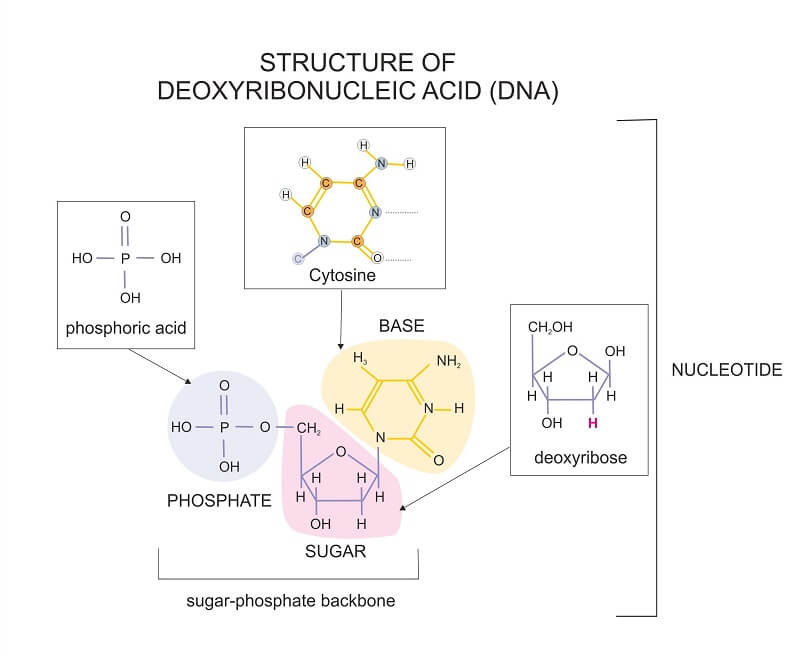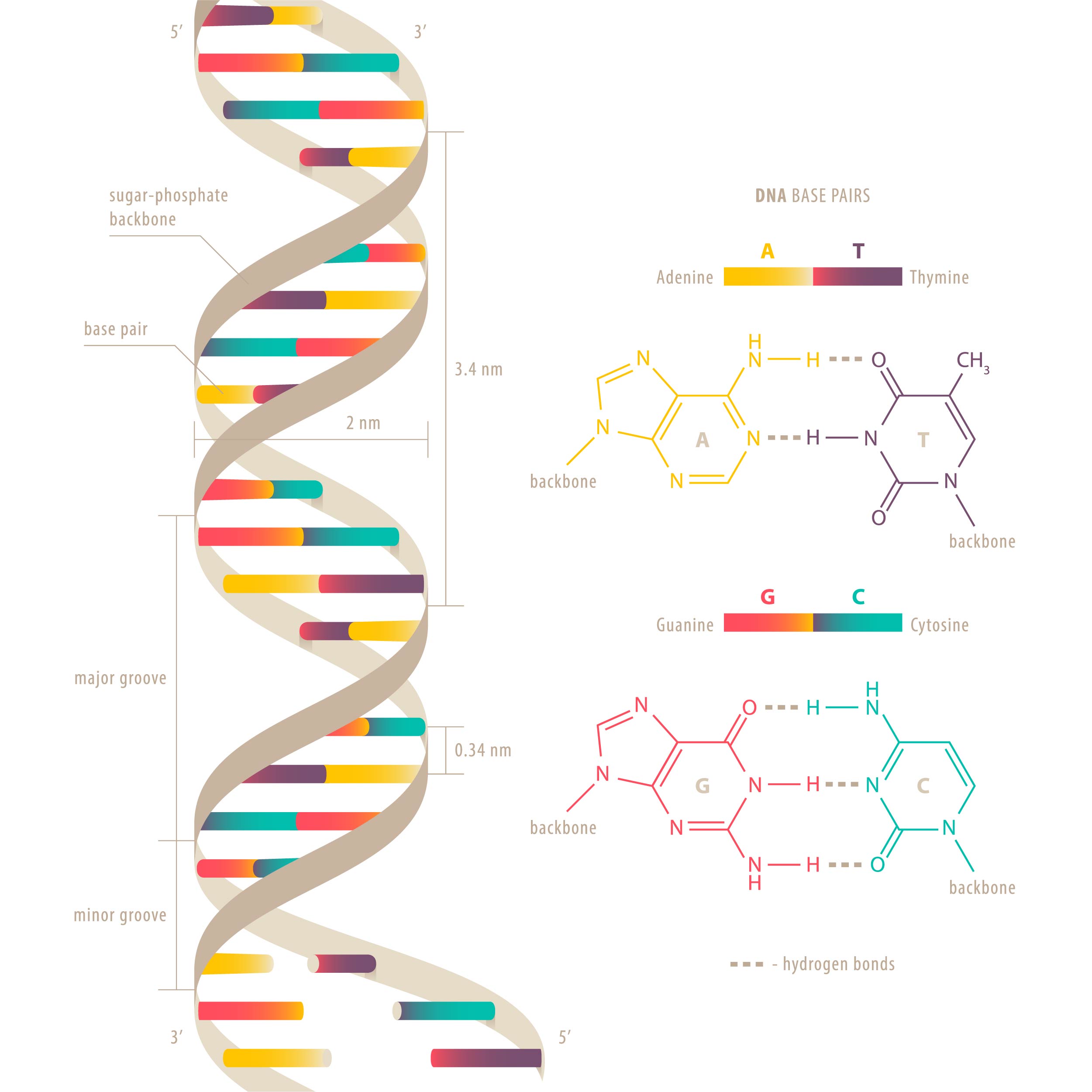Definition
Double helix is the term used to describe the shape of our hereditary molecule, DNA. This instantly recognizable structure consists of two strands of DNA twisted around one another and connected in the center by hydrogen bonding. The hydrogen bonds form between nucleotides – the repeating unit of DNA and the language of the genetic code.
The double helix structure of DNA was uncovered in landmark research attributed to James Watson and Francis Crick in the 1950s. This finding is considered one of the most important advances in biology to date. The story of the discovery of the DNA double helix also has some controversies attached, with claims that the involved scientists failed to recognize the contributions of others, namely Rosalind Franklin.

An Overview of the Structure of DNA
Each strand of DNA is made of a series of repeating units called nucleotides. Hence, each strand of DNA is referred to as a polynucleotide. These nucleotides are formed of three components:
- a five-carbon sugar (deoxyribose)
- a phosphate group
- a nitrogenous base
The 4th carbon of the deoxyribose sugar from one nucleotide forms a phosphodiester bond with the phosphate group of the adjacent base. This forms the basis of the sugar-phosphate backbone of the strand of the DNA.
The nitrogenous bases are the ‘language’ of the DNA. There are four nitrogenous bases in DNA: guanine (G), adenine (A), thymine (T) and cytosine (C). They can be divided into two groups based on their structure. Guanine and adenine are purines, with a two-carbon nitrogen ring; and thymine and cytosine are pyrimidines, with a one-carbon nitrogen ring.
The combination of these four letters in molecules of DNA is what we call the genetic code, and this code contains all the instructions to build and run an entire organism!
Each of these polynucleotide strands is paired with a complementary strand and wraps around one another to form the double helix structure. How was this complex structure uncovered?

The Discovery of the Double Helix Structure of DNA
The discovery of the double helix structure of DNA is one of the most important and well-known scientific breakthroughs. The discovery was credited to James Watson, a biologist, and Francis Crick, a physicist, in the 1950s. They later won the Nobel Prize for their research, along with Maurice Wilkins, who is often overlooked for his important role in the research that led to the breakthrough. In fact, his autobiography is titled “The Third Man of the Double Helix”.
Prior to the publication of their findings, much research had already been carried out, and some light shone, on the composition of DNA. For example, it was already known that DNA is composed of nucleotides and that the ratio of purines: pyrimidines in a molecule of DNA is equal (known as Chargaff’s rule).
Watson and Crick derived their model by putting this evidence, as well as X-ray crystallography data collected by Rosalind Franklin, into a structure that satisfied the parameters of all of the previously collected evidence. They used a series of cardboard models, carefully constructing them until they formed a structure that made sense. Through this, they created a model, which is broadly considered accurate decades later. You can read the original paper, complete with annotations, here.
Once they completed their research, they purportedly had a ‘eureka’ moment, and Crick ran to their local pub in Cambridge to announce that he and Watson had “discovered the secret to life.”
The pub, called The Eagle, erected a plaque inside and one outside to commemorate the occasion. The plaque was once modified by a member of the public, who added “+ Franklin in recognition of the important role played by Rosalind Franklin!

The Features of the DNA Double Helix Structure
Some of the important features of the Watson/Crick model of the DNA double helix include:
Helix Directionality
A single molecule of DNA consists of two strands that twist around one another to form a helix. The helix turns approximately once every ten nucleotides. The direction of the helix is almost always right-handed, i.e., if you imagine the two strands like a spiral staircase you are about to walk down, you would have to turn right to descend. The outside of the helix contains the DNA strands, and the core of the helix contains the nitrogenous bases.
Complementary Base Pairing
When the nucleotides from each strand undergo hydrogen bonding, they do so in a particular manner. Adenines are always paired with thymines and cytosines and always paired with guanines. There are three hydrogen bonds between guanine and cytosine, and two hydrogen bonds between thymines and guanines. Thus, strands of DNA are said to be complementary to one another.
Genetic Code
The sequence of the nucleotides is variable between organisms, and is what holds the genetic information and makes each organism unique. The sequence of the DNA is propagated between generations. Thus, the DNA sequence is essential for the continuation of life.
Antiparallel Orientation
The DNA strands run antiparallel to one another. This means that at the end of a particular molecule, one strand ends on a phosphate group (called the 5’ because the phosphate group is attached to the fifth carbon), and the other strand ends on a hydroxyl group (called the 3’ because the OH group is on the third carbon). The opposite is true for the other end of the molecule.
Major and Minor Grooves
The structure of DNA means that the backbone of the two strands is closer together on one side of the helix than the other. Where they are closer, the structure is called the major groove. Where they are further apart, the structure is called the minor groove.
These sides are functionally important, as certain proteins preferentially bind to the major groove. These proteins are usually factors that need to interact with the nucleotides, such as transcription factors or DNA replication enzymes. In contrast, other proteins that do not require sequence-specificity will interact with the minor groove.

The Unwinding Enzyme
For DNA to be passed on to the next generation, it has to be copied. To be faithfully replicated, the double helix needs to be unwound or unzipped, so that the cell machinery has access to the nucleotide sequence. This unzipping is achieved by the enzyme helicase.
The function of helicase is to remodel the structure of DNA by breaking the hydrogen bonds between the paired nucleotides. DNA helicase is also important during the repair of DNA damage and the process of transcription.
Alternative DNA structures
Watson and Crick’s model refers to the most common structure of DNA, called B-DNA. Two more conformations of DNA are much rarer in nature: Z-DNA and A-DNA. Z-DNA is a left-handed helix with no strong differences that define major and minor grooves. A-DNA is much more similar in structure to B-DNA but is more compressed and compact.
Quiz
